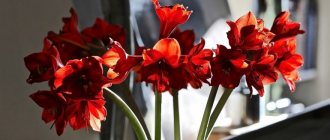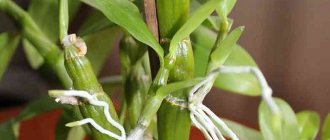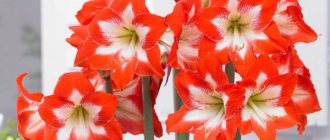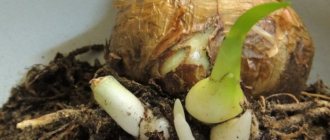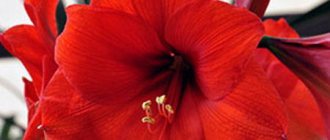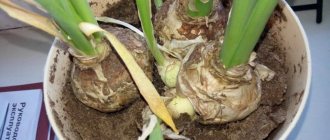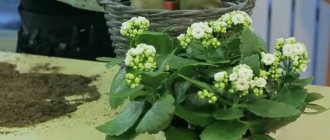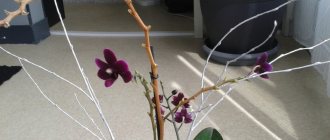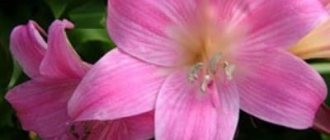Rules for purchasing in the store
If you decide to buy an adult plant for your home collection, then it is better to purchase it during flowering. This way you can avoid making a mistake with the color and buy the flower you like best. The plant must be healthy and strong, without signs of disease, rot or spots on the leaves.
Purchasing bulbs for growing
It is advisable to buy bulbs in autumn or spring. When choosing, you should pay attention to their appearance. There should be no dry, soft or rotten areas on the bulbs.
Read here which plant varieties are best suited for indoor growing.
How to plant amaryllis bulbs
Why amaryllis does not bloom at home - what to do
The bulb can be planted both in spring and autumn. The flowerpot should be deep and narrow. Bulbs have very long roots and need a lot of space. A drainage layer of expanded clay or pebbles is placed at the bottom of the pot; it will not allow water to linger in the roots. For planting, you can take a mixture of peat, leaf, turf soil, or use a ready-made substrate.
Step-by-step instructions for planting and caring for amaryllis:
- The bulb is carefully examined, the rotten roots are cut off.
- The rhizome is placed in a container with potassium permanganate.
- The bulb is carefully placed 2/3 into the soil, leaving 1/3 of the tuber on the surface.
- Water must be poured into the pan.
- If necessary, water with liquid fertilizers.
Planting amaryllis with a bulb
Location and lighting
Amaryllis is very demanding when it comes to lighting. Daylight hours should be at least 16 hours a day. These flowers are always reaching for the sun.
The flower should be placed on south or southeast windows.
In summer, it is necessary to shade it from the scorching rays of the sun to prevent the plant from burning. In winter, it is necessary to ensure that there are no drafts in the room, as they are dangerous for the flower.
How does amaryllis propagate?
The May lily propagates in three ways: by seed, by dividing the bulb and by children. To propagate by division, you need to choose the healthiest bulb. Make 4 cuts on it, without bringing the knife to the end. Treat the sections with activated carbon. The tuber is placed in a pot and germinated at a temperature of 25 -27 degrees. When the second leaf appears on the plant, the flower is transplanted into a new pot.
Dividing the bulb
Reproduction by children is the simplest method. The children do not need a period of rest; they are immediately planted in the soil. After planting, the plant is watered abundantly and fertilized. Dormancy is organized after flowering has ended.
Humidity, watering and spraying
The watering schedule depends on the growth period of the plant.
When a flower has a flower shoot of 5-10 cm, the plant should be watered frequently. To avoid overflow, it is advisable to use gentle humidification through a tray. When watering in the usual way, it is necessary to drain off excess water. Otherwise, due to stagnation of moisture, the root system may begin to rot.
After the buds have bloomed, the frequency of moisturizing must be gradually reduced and gradually stop watering altogether.
If the room has normal humidity, then amaryllis does not need constant spraying. This should only be done if the air in the room is dry and the soil dries out very quickly. During the rest phase, you can spray the soil once every 3 weeks to prevent it from drying out completely.
Amaryllis: home care
Content temperature
Amaryllis has a pronounced dormant period, during which it completely dies and only the bulb remains. During this period, the pot with it is stored at a relatively cool temperature. It is approximately +10-13 degrees with low air humidity. It's a completely different matter during the growing season. During this period, amaryllis will need a temperature of +20-25 degrees, that is, normal room temperature. There is a small nuance to this.
Advice. To achieve the greatest likelihood of flowering and increasing its duration, it is advisable to create conditions such that the night temperature is 5-6 degrees lower than the day temperature. In this respect, amaryllis is similar to phalaenopsis.
Lighting
During the growing season, amaryllis lighting should be at least 14 hours a day. In this case, the light should be as bright as possible. Like most houseplants, direct sunlight can cause significant damage to amaryllis. Therefore, it is better to place it near windows facing east or west. When placed near southern windows, it must be protected from the scorching sun.
Watering, air humidity and fertilizing
The first time, it is advisable to water the sprouted leaves with warm water and then do so only after the soil dries, but make sure that there is no “souring.” And during the dormant period, do not water at all.
The desired air humidity level for amaryllis is average. But if the temperature exceeds the recommended one and the air dries out, it is recommended to humidify it.
I do not advise you to spray amaryllis leaves. Limit yourself to wiping the leaves with a damp cloth. To humidify the air, it is better to place the amaryllis pot on a tray with damp expanded clay or place such a tray next to the plant. In this case, it is better to fill it with damp moss. If desired, you can use any other method of humidifying the air.
Amaryllis is fed only during the growing season. Experienced flower growers, who have many different fertilizer ingredients in their arsenal, feed it with mullein infusion. But novice flower growers are better off using ready-made fertilizers for bulbous plants. In this case, be sure to pay attention to the nitrogen content in such fertilizer. It doesn't have to be big. Otherwise, the foliage will be lush and the flowering will be sparse.
Preparing for the rest period
This period is very important when growing amaryllis. If the plant is deprived of it, the bulb will deplete very quickly, and as a result, it will grow poorly and, of course, bloom worse. Amaryllis should be prepared for the dormant period immediately after flowering. Feeding is stopped completely, and watering is gradually reduced in frequency and volume. When the entire above-ground part has withered, it is cut off and the pot with the bulb is moved to a cool, dry place.
Planting and replanting amaryllis
Transplantation can be carried out either after the amaryllis blooms, or at the end of the dormant period. On average, replanting is carried out once every three years, but if the pot is clearly small, then it can be done earlier. In the intervals between transplants, after a period of rest, it is advisable to renew the top layer of soil in the pot.
Advice. If you are just planning to get amaryllis, then take the choice of bulb seriously. It should be smooth, without signs of mechanical damage or signs of rotting. Be sure to smell it. It shouldn't smell bad. The optimal size of an amaryllis bulb for planting is approximately 7 centimeters.
Be also careful when choosing a pot. The above-ground part of the amaryllis is very heavy and, despite the earthen ball, a light plastic pot can easily tip over. Therefore, it is better to opt for a heavy ceramic pot. Moreover, it allows air to pass through to the roots much better. The size of the pot for amaryllis directly depends on the size of the bulb. It should be selected in such a way that there is no more than 3 centimeters from the bulb planted in the center from its edge to the edge of the pot. Planting in an overly large pot will slow down the flowering time. Amaryllis are often planted in a group of 3 plants in a large pot. In this case, the same rule is followed - the distance between the bulbs should be at least 3 centimeters.
The soil mixture for transplanting and planting amaryllis can be taken ready-made for bulbous plants. You can cook it yourself. The components of such soil are simple and accessible.
- Sod land - two parts;
- Leaf soil - two parts;
- Humus - one part;
- Sand is one part.
Before planting an amaryllis bulb, thoroughly wash the pot, or even better, sterilize it. Also sterilize the soil for planting and drainage. Inspect the bulb, remove old dark scales. It is advisable to soak it for 30 minutes in a solution of any fungicide before planting. Then dry it.
The amaryllis bulb should be planted so that a third of it is above the ground.
Landing
Before planting, you need to remove all the dark scales from the bulb so that it becomes light green. After this, the bulb is soaked for 30 minutes in a weak solution of potassium permanganate or any fungicide. Then it is dried for a day and planted in nutritious soil.
Step-by-step instructions for replanting amaryllis can be found here.
Amaryllis - what kind of bulbous flowers are they?
Amaryllis flowers are native to South Africa. In the hot African climate, they come to life only twice a year: in February and August, during the period of heavy rains. Until this time they are in hibernation. During heavy rains, the earth is filled with moisture and dry roots begin to come to life. After heavy rains the heat sets in. The inflorescence, leaves and stems die, the root dries out until the next rainy season.
Amaryllis in the wild
Brief description, what it looks like, distinctive features
Amaryllis is a perennial bulbous plant. The description of a flower can begin with its root system. It is a round bulb, slightly elongated at the edges. The tuber size is about 5 centimeters in diameter. Thin roots protrude from the bottom.
The leaves are narrow, rich green. They grow up to 55 centimeters. The shape resembles a thin sword, up to 3 centimeters in diameter. They are located on the stem in pairs. In the natural environment, during flowering, there are no leaves. Indoor lilies have leaves, but in small quantities.
Note! When the flower blooms, there are no leaves. The buds bloom immediately after waking up, then the foliage appears.
From 4 to 6 flowers grow on long peduncles, which are collected in an umbrella inflorescence. The diameter of one flower is up to 12 centimeters. The bud is shaped like a bell with six petals. They can be of various colors (white, cream, orange, pink, red) with long stamens located in the middle. The last week of April and the beginning of May is when amaryllis blooms. Flowering lasts about two weeks.
It is rare to see real amaryllis on window sills in Russian apartments; it is often replaced by its relative hippeastrum. This is due to the fact that hippeastrum quickly gets used to the Russian climate. Hippeastrum is a flower with leaves like amaryllis, so they are easily confused. The difference can be seen in the color of the bud; in hippeastrum it is brighter.
How to propagate (pictured)?
Reproduction occurs in the following ways:
- Seminal. This is a labor-intensive method, so it is rarely used. To obtain seeds, flowers will have to be pollinated by hand using a brush, transferring pollen from one flower to another. When the seed box dries and cracks, the resulting material can be planted in moist and nutritious soil.
- Daughter bulbs. If cared for correctly, the plant forms daughter bulbs. They are carefully separated and planted in a substrate consisting of sand and peat or perlite. When the bulbs grow, they are transplanted into a larger container.
- By dividing the bulb. At the end of flowering, cut off the neck with leaves from the bulb and divide it into equal parts. Toothpicks or knitting needles are inserted into the cuts. After some time, the formed new bulbs are transplanted. Watch the video to see how this happens:
Types and varieties of amaryllis
For a long time, amaryllis was considered a plant of the same type. Now there are two main types of decorative flowers:
| View | Description |
| Amaryllis belladonna | Develops from elongated, round, pear-shaped large bulbs. Green stem 0.5 m high. Has a pleasant, delicate aroma. Belladonna blooms in winter and goes dormant in summer. |
| Amaryllis Paradisicola | It differs in the number of inflorescences: there are 21 of them. It has a pungent odor. Pink flowers. The saturation of the shade increases as the buds open. It has not become widespread in indoor floriculture. |
Based on these species, breeders have developed new varieties. They are distinguished by color, shape, size of flowers:
| Variety | Flower |
| Durban | It is shaped like a bell. Red with a light spot at the base. |
| Parker | Pink with a yellow center. |
| The Snow Queen | Snow-white glossy flowers with a beige edge. |
| Faith | Light pink with a pearly finish. |
| La Paz | Green with red border. |
| Macarena | Terry purple with white stripe. |
| Minerva | Variegated striped petals. |
| Grandior | Gradient transition from soft pink to a more saturated shade. |
You can get an unusual hybrid yourself. During flowering, pollen is collected from the stamens of one variety and transferred to another species. From the obtained seeds, a new variety is grown that combines the parental color.
Diseases and pests
The most common pests that can appear on amaryllis are:
- onion mite;
- false scale insect;
- slugs;
- daffodil fly;
- mealybug;
- thrips.
Fungicides and insecticides are used to treat and destroy parasites. They must be used in accordance with the instructions for the drug.
Most often, the plant suffers from fungal diseases, which usually occur when the plant is overwatered and has excess moisture. Red spots or stripes appear on the leaves, peduncle and buds. Foundationazole or a solution of Bordeaux mixture will help get rid of rot.
Decorative flower varieties (names with descriptions)
Amaryllis - home care after flowering
There are several varieties of flowers that can be grown at home:
- Durban (Amaryllis Durban). The variety is represented by bright red, double buds. The petals are long, pointed with white breaks inside.
- Nymph (Amaryllis Nymph). The petals are white with pink veins. The structure of the buds resembles a peony. It will grow up to 45 centimeters, resembles a lush ball with a large number of petals.
- Parker (Amaryllis Parker). The petals are soft pink with a yellow center.
- The Snow Queen. White amaryllis is distinguished by its snow-white, wavy petals, which have a glossy coating.
- Double dream. Terry petals of a coral shade with a white border around the edge. They resemble the nymph variety.
- Ferrari. Amaryllis buds are red, the stem height is about 60 centimeters.
- Macarena (Amaryllis Macarena). Terry red petals with white stripes give the flower a unique charm.
Variety Nymph
Problems associated with growing the plant
Often when a flower is gestating, it happens that it does not bloom. There is no flowering for the following reasons:
- The pot is too large, instead of forming buds, babies grow around the rhizome.
- If the tuber is planted very deep in the soil.
- Missing useful elements.
- The plant does not receive enough light and heat.
- Root system rotting.
- The bulb is infected with fungi and parasites.
Additional Information! After planting the bulb, the first inflorescences appear after 3-4 years. If propagation took place by seed, you will have to wait 5-7 years.
Diseases and pests
If not properly cared for, the plant can become infected with the following diseases:
- Stagonosporosis. The leaves, stem and rhizome become covered with red spots. The disease develops against the background of a sharp drop in temperature and high humidity. If a disease is detected, the bulb must be placed in a solution of potassium permanganate for two hours, then the affected areas should be cut off.
- Gray rot. Gray spots appear on the leaves. The leaf dries and then falls off. The reason is incorrect watering regime and excess moisture. Fungicides are used.
- Fusarium. The leaves turn yellow and wither. This is due to the appearance of fungus on the bulb and temperature changes.
- Anthracnose. It is manifested by the appearance of dark spots and brown smudges on the leaves. The plant is treated with Fundazol or Fitosporin and transplanted into new soil.
Among the pests that attack the flower are:
- Spider mite. The leaves and stems are covered with a thin web. The parasite sucks the juice from the plant and it dies. You can get rid of the pest with Floromite or Neoron.
- Thrips. Small black dots can be observed on the leaf. The plant must be treated with Agravertin and Fitoverm. Then it will be transplanted into a sterile pot.
- Aphid. Yellow spots appear on the leaf blade. You can get rid of aphids with a soap solution.
Amaryllis is an excellent houseplant that can be grown outdoors. In order for a flower to delight with lush buds, it is necessary to properly care for it. In amaryllis, the propagation process is quite simple, which even an amateur gardener can handle.
Problems
- The flowers are turning pale . Reason: direct sunlight;
- The flowers darken or even turn black. Reason: damp air and low room temperature;
- The leaves become pale and the flowers droop. Reason: insufficient watering;
- The leaves are turning yellow . Causes: damage by thrips or aphids, waterlogging of the soil;
- The bulbs are getting smaller. Reasons: a large number of children, lack of lighting, abundant flowering;
- The plant does not bloom . Reasons: improper care, too short or no rest period, deep planting of the bulb, damage to the root system. The bulb will not have enough strength to release a peduncle if there is a lack of heat, light, fertile soil, drainage and sufficient watering. During the dormant period, the bulb accumulates strength for flowering.
On what soils does a flower grow in nature?
Hippeastrums are called Cavalier or Knight's Stars (literal translation - cavalier, horseman and star) for their bright large funnel-shaped flowers, similar in shape to lilies. The flowering bulbous perennial crop belongs to the Amaryllis family.
Fact . Until the middle of the 20th century. Hippeastrum and Amaryllis were considered representatives of not only one family, but also one genus. In 1954, on the recommendation of the International Congress of Botanists, the plants were divided into two independent, separate generic varieties.
The distribution zone under natural conditions is tropical and subtropical regions of America. Most species representatives grow on the coasts of the Amazon.
The habitat of exotics is the Antilles, mountain slopes (Andes in Peru), the plateaus of Mexico, spacious meadows. Some species (for example, Hippeastrum virginia) prefer shady forests and humid areas of northern and southern Brazil.
The natural composition of the nutrient soil is humus from fallen leaves and twigs, coarse sand and turf.
Bloom
Flowering occurs after a period of dormancy. It is believed that it occurs in autumn. If desired, amaryllis can be made to bloom at any time of the year. To force the peduncle, the flower will need to be removed to a dark and dry place. It is not recommended to cut off the foliage; the beneficial substances from it will pass into the bulb, and the foliage will die off on its own.
At this time, watering is stopped completely and you can forget about the flower for a couple of weeks. To joy and surprise, after such loneliness, he will show the “nose” of the peduncle. With its appearance, the flower is taken out to the windowsill and moderate, but not abundant watering and fertilizing is started. Excess moisture will promote the growth of foliage and reduce the strength of the peduncle.
Reaching a height of 50 cm, the peduncle shows swollen buds in which flowers of wondrous beauty are hidden. The opening of the first flower has a variable period, approximately 2 weeks after the start of growth. It is better to place blooming amaryllis in a shady place, so its flowering will last longer (15-20 days). An amaryllis flower with a young bulb blooms in the 3rd year, and grown from a seed in the 7th year.
The peduncle can be cut and placed in a vase with water; it will remain there for at least 2 weeks. Thus, the bulb is not depleted and is able to please the owner with a new flowering arrow
